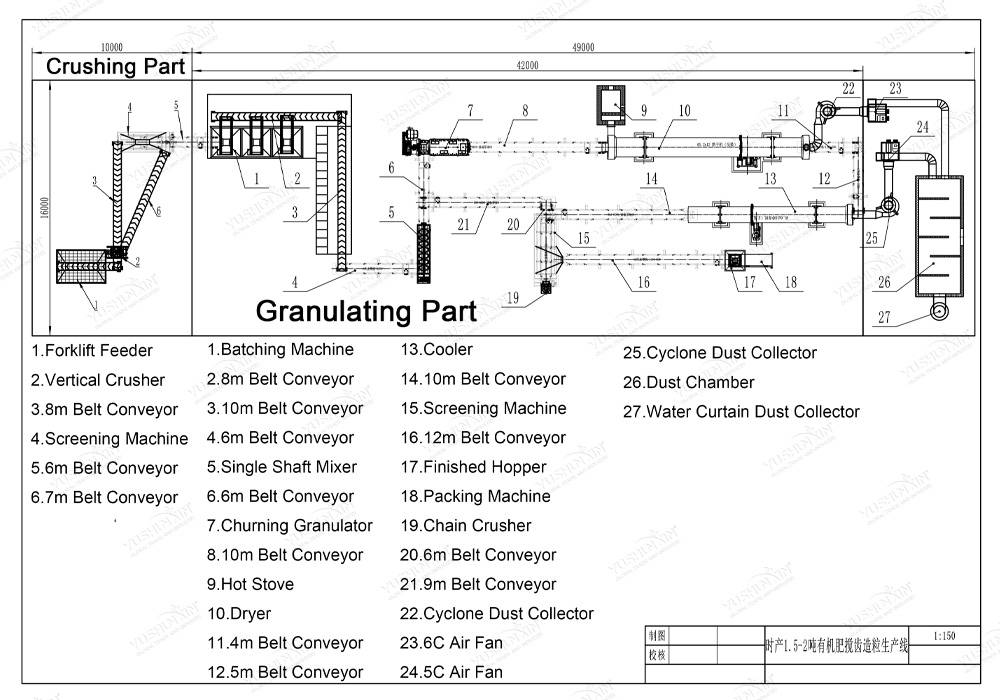







Để chuyển đổi phosphate đá thành dạng phân bón có thể sử dụng, axit được yêu cầu “Fizzy” Đá, giải phóng các hợp chất phốt pho hòa tan. Các axit thông thường được sử dụng bao gồm:
Để tạo Phân bón NPK, Các nguồn nitơ và kali khác có thể được trộn với vật liệu phốt phát. Một số ví dụ bao gồm:
Chi phí của mỗi dây chuyền sản xuất thay đổi tùy thuộc vào năng lực sản xuất, mức độ tự động hóa, và nhu cầu cụ thể. Điền vào biểu mẫu bên dưới và chúng tôi sẽ cung cấp cho bạn một báo giá chính xác!
Nếu bạn quan tâm đến thiết bị sản xuất phân bón của chúng tôi, Vui lòng gửi các yêu cầu và liên hệ của bạn và sau đó chúng tôi sẽ liên hệ với bạn sau hai ngày. Chúng tôi hứa rằng tất cả thông tin của bạn sẽ không bị rò rỉ cho bất kỳ ai.
- Công ty được thành lập trong 2005 và đã tập trung vào nghiên cứu và phát triển và sản xuất các thiết bị phân bón hữu cơ cho 20 năm. Nó đã xây dựng một cơ sở sản xuất thiết bị phân bón hữu cơ quy mô lớn 40.000m, Sử dụng hạt tiên tiến, Công nghệ sấy và sàng lọc để cải thiện hiệu quả sản xuất và chất lượng sản phẩm.
- Một doanh nghiệp nhập khẩu và xuất khẩu tự vận hành với nhiều hơn 80 Kỹ sư chuyên nghiệp trên toàn thế giới, phục vụ nhiều hơn 100 Các quốc gia và khu vực trên thế giới, 5,000+ trường hợp dịch vụ khách hàng, 10 trung tâm xử lý, 3 Máy cắt laser, Và hơn cả 60 Thiết bị thuộc nhiều loại.
- Duy trì sự hợp tác lâu dài và rộng rãi với nhiều viện nghiên cứu khoa học và trường đại học, with a professional R&D team, Nó có thể liên tục tối ưu hóa hiệu suất thiết bị theo nhu cầu thị trường.
- Vật liệu chống mài mòn cao, Thép carbon Q235/Hợp kim được chọn để đảm bảo rằng thiết bị bền và giảm chi phí bảo trì.
- Áp dụng các hệ thống kiểm soát thông minh để cải thiện mức độ tự động hóa sản xuất và giảm sự phụ thuộc thủ công.
- ISO, CE, Chứng nhận quốc tế SGS
- Với năng lực sản xuất quy mô lớn, nó có thể đáp ứng các yêu cầu năng lực sản xuất khác nhau (bé nhỏ, dây chuyền sản xuất trung bình và lớn).
- Một loạt các mô hình thiết bị, Thích hợp cho việc sản xuất các loại phân bón khác nhau như phân bón hữu cơ, Phân bón hợp chất, Phân bón sinh học, Phân bón hòa tan trong nước, Phân bón lỏng, vân vân.
- Thiết kế được cá nhân hóa có thể được cung cấp theo nhu cầu của khách hàng, bao gồm cả năng lực sản xuất, Bố cục trang web, Tiêu chuẩn bảo vệ môi trường, vân vân.
- Cung cấp một bộ hoàn chỉnh các giải pháp dây chuyền sản xuất, bao gồm lựa chọn thiết bị, Cài đặt và vận hành, Đào tạo kỹ thuật, vân vân.

- Cung cấp nhà máy trực tiếp, Giảm liên kết Middman, và giá cạnh tranh hơn.
- Thiết bị có hiệu quả năng lượng cao, Giảm tiêu thụ năng lượng, và giúp khách hàng giảm chi phí vận hành dài hạn.
- Cung cấp nhà máy trực tiếp, Giảm liên kết Middman, và giá cạnh tranh hơn.
- Thiết bị có hiệu quả năng lượng cao, Giảm tiêu thụ năng lượng, và giúp khách hàng giảm chi phí vận hành dài hạn.
Cung cấp Máy đánh bóng phân bón cho nhà sản xuất phân bón hàng đầu Hà Lan
Giao thành công máy tạo hạt con lăn đôi 1T/H cho khách hàng ở Thổ Nhĩ Kỳ và Vương quốc Anh
Giải pháp đảo trộn phân hiệu quả được giao cho khách hàng Philippine
Giao thành công máy tạo hạt dạng đĩa cho khách hàng Chile để sản xuất phân bón